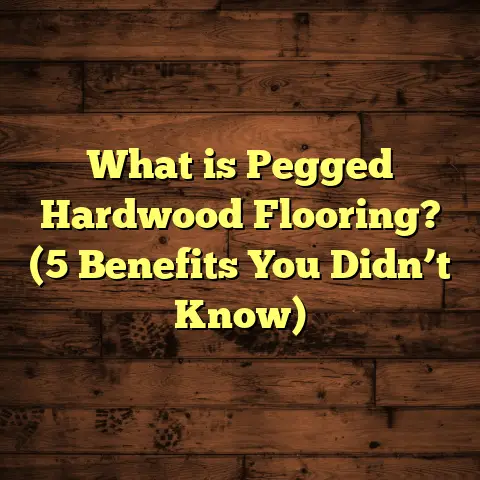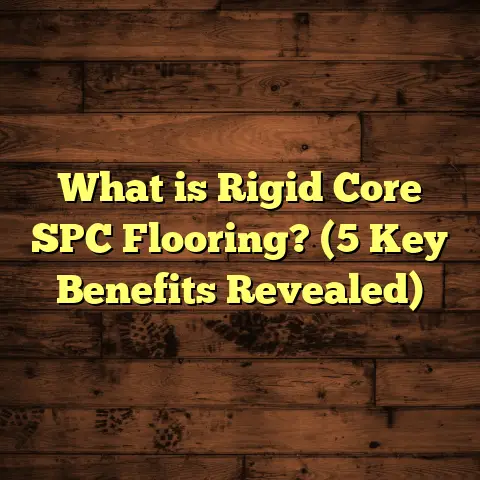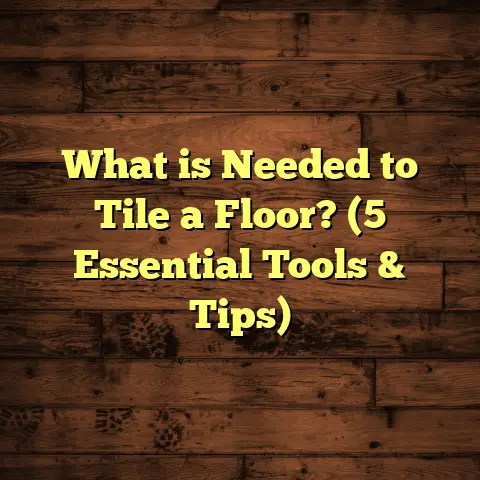What is a Lower Floor Called? (5 Types Explained Clearly)
Imagine stepping into a house for the very first time,
your eyes naturally dropping to the space beneath your
feet. Maybe you’re in an old house, or looking at blueprints
for a new build. You notice the floor levels — the main floor,
maybe an upper floor or two — but what about the floor below?
What do you call that lower floor exactly? Is it a basement, a
crawl space, or something else entirely? These questions came
up frequently during my years working in flooring installation
and home renovation, where knowing exactly what part of the
building you’re dealing with can make all the difference.
Lower floors are not just about being “downstairs.” They come in
different forms, each with its own name, purpose, and set of
considerations for construction, maintenance, and design. I’ve
encountered all sorts of lower floors — from damp basements to
tiny crawl spaces and even hidden cellars — and each presented
its own unique challenges and opportunities.
So, what exactly is a lower floor called? What types should you
know about? Let me walk you through five key types of lower floors,
sharing some stories, data-backed insights, and tips based on my
experience.
What is a Lower Floor Called?
Simply put, a lower floor refers to any level of a building that is
below the main or ground floor. But this term covers quite a few
different spaces that serve various functions and come with
distinct names. The most common ones are:
- Basement
- Crawl Space
- Cellar
- Subfloor
- Ground Floor (in some regions)
Each has different structural characteristics and uses. For example,
a basement is often a fully enclosed, finished or unfinished space below
the main living area. A crawl space is a shallow, unoccupied area that
provides access to pipes and wiring. A cellar traditionally stores food or wine. The subfloor is a structural layer beneath your finished flooring. And in some countries, the “ground floor” is considered the lowest floor.
Understanding these distinctions isn’t just academic — it helps when planning
flooring projects, troubleshooting moisture issues, or estimating costs.
1. Basement: The Most Recognizable Lower Floor
When I think of lower floors, basements immediately come to mind. They’re probably the most common type we think of in North America as “the lower level.”
What Defines a Basement?
A basement is a space that is at least partially below ground level and usually extends beneath the entire footprint of the house.
- It can be finished (with drywall, flooring, heating) or unfinished (just concrete walls and floors).
- Often used as extra living space, storage, laundry rooms, or mechanical rooms.
- Can sometimes have windows providing natural light.
- Usually has concrete or masonry walls for structural support.
Why Are Basements Popular?
Basements add valuable square footage without increasing the house’s footprint. They can increase a home’s value and provide flexible space for families.
My Experience with Basement Projects
I remember working on a basement remodeling project for a young family. The original basement was cold and damp with exposed concrete walls and a dirt floor in one corner due to poor drainage. They wanted a cozy playroom and media area for their kids.
We started by fixing moisture problems — installing a sump pump system, sealing walls with waterproof paint, and putting down a vapor barrier under the subfloor. We then laid down engineered hardwood flooring with proper underlayment designed for below-grade use.
The transformation was incredible. The family loved having extra living space that felt warm and inviting instead of cold and musty.
Common Basement Challenges I’ve Encountered
Basements can be tricky because they’re prone to moisture issues:
- Water seepage: Groundwater can penetrate poorly sealed foundations.
- Humidity: Basements tend to have higher humidity levels.
- Mold and mildew: Dampness leads to mold growth if not addressed.
- Cold floors: Concrete slabs can feel cold without proper insulation.
Dealing with these requires careful waterproofing, drainage solutions (like French drains or sump pumps), and choosing moisture-resistant flooring materials such as vinyl planks or tile.
Data Insight: How Common Are Basements in Homes?
According to the U.S. Census Bureau data from recent years:
- Roughly 50% of homes have basements.
- In colder climates like the Midwest and Northeast USA, basements are more common due to frost line requirements.
- In southern states with high water tables or rocky soil, basements are less common.
This regional variation impacts your choice of lower floors when planning construction or renovations.
2. Crawl Space: The Narrow Hidden Area Beneath
If basements are wide open spaces under your home, crawl spaces are their smaller cousins—narrow areas just high enough to crawl into but not stand up.
What’s the Purpose of Crawl Spaces?
Crawl spaces provide access to plumbing, electrical wiring, HVAC ductwork, and foundation components without needing full basement height.
They’re typically:
- 18 to 36 inches high
- Underneath houses built on piers or foundation walls
- Not designed for living or storage
Why Are Crawl Spaces Used?
They raise the home off the ground slightly to reduce moisture problems compared to slab foundations.
Personal Story: Learning About Crawl Spaces
Early in my career, I encountered my first crawl space during a floor repair job. The homeowner complained of musty smells inside the house. When I inspected below, I found a crawl space full of damp soil but no vapor barrier.
This allowed moisture to rise into the subfloor above, causing wood rot and mold growth. After sealing off vents, installing a heavy-duty plastic vapor barrier over the soil, and adding a dehumidifier, the air quality improved significantly.
Problems Associated With Crawl Spaces
Common issues include:
- High moisture leading to mold
- Pest infestations (termites love moist wood)
- Poor ventilation causing stale air
- Difficulty accessing pipes in tight spaces
Proper ventilation or encapsulation (sealing crawl spaces) has become more common as builders realize it prevents many problems.
Data Point: Prevalence of Crawl Spaces in Construction
The U.S. Department of Energy estimates that about 30% of homes have crawl spaces instead of basements or slab foundations.
In warmer regions like the southern U.S., crawl spaces are often preferred due to soil conditions and cost savings compared to basements.
3. Cellar: The Traditional Storage Spot Below Ground
Cellars are somewhat similar to basements but historically had distinct uses.
What Exactly is a Cellar?
A cellar is usually an underground room designed primarily for storage rather than living space. It often has:
- Stone or brick walls
- Dirt or concrete floors
- No modern insulation or finishing
Cellars were commonly used before refrigeration to store food like root vegetables, canned goods, wine, or beer in cool, stable temperatures.
My Experience Restoring Old Cellars
I once helped restore an old farmhouse with a root cellar that had fallen into disrepair. The owners wanted to preserve its historic character but make it safe for storing wine collections.
We reinforced stone walls with breathable lime mortar (to avoid trapping moisture), added temperature monitoring systems, and installed slip-resistant stone flooring. The project blended old-world charm with modern functionality.
Differences Between Cellars and Basements
- Basements are often larger and intended for living or utility use.
- Cellars are smaller and primarily for storage.
- Cellars are typically cooler and damper.
- Basements usually have more modern finishes.
4. Subfloor: The Foundation Beneath Your Flooring
This one might surprise you because it’s not an entire room but an essential part of your flooring system.
What Is A Subfloor?
The subfloor is the structural layer directly above the joists that supports your finished flooring (like hardwood, carpet, tile).
Most subfloors are made from:
- Plywood sheets
- Oriented Strand Board (OSB)
- Occasionally tongue-and-groove planks in older homes
Why Should You Care About Subfloors?
Your flooring’s durability and feel depend heavily on a solid subfloor:
- A weak subfloor leads to squeaky floors.
- Uneven subfloors cause gaps or cracking tiles.
- Water damage here can ruin your entire floor system.
When Have I Seen Subfloor Problems?
On several jobs where water leaked from above or below (like busted pipes or crawl space moisture), I found subfloor wood swollen or rotted. Replacing these sections was necessary before installing new flooring.
How I Use FloorTally for Accurate Cost Estimation
Estimating costs for subfloor repairs can be tricky because damage extent varies widely. I use FloorTally—an online tool that helps calculate material needs and labor costs based on location-specific prices.
It factors in waste percentages for cuts and mistakes too—which saves me from ordering too little or too much material. It also helps me visualize total project costs quickly so I can give clients realistic estimates without multiple contractor quotes.
5. Ground Floor: The Lowest Level in Some Regions
In many parts of the world outside North America (like Europe), what we call the “first floor” is actually one level above what they call the “ground floor.” So here, the ground floor is effectively the lowest floor of the building.
Why Does This Matter?
If you’re working internationally or reading architectural plans from other countries, knowing this terminology prevents confusion about which level is being discussed.
For example:
- In the UK: Ground floor = street level; First floor = above that.
- In the U.S.: First floor = street level; Second floor = above that.
How Does This Affect Flooring Decisions?
Ground floors may require specific considerations like:
- Better insulation against cold/humidity from direct contact with earth.
- Durable flooring that withstands foot traffic entering from outside.
- Moisture barriers if built over slabs or soil.
More About Lower Floors: Their Role Beyond Just Levels
Lower floors are more than just levels below your main living areas—they play important roles in:
- Supporting the structure above
- Housing utilities like plumbing and wiring
- Providing storage or additional living space
- Managing moisture and temperature differences from outdoors
Success Stories & Lessons Learned From My Work on Lower Floors
Success Story 1: Turning a Basement Into a Rental Unit
A client wanted to turn their unfinished basement into a separate rental suite to generate income. We tackled moisture sealing first — installed drainage systems around the foundation, added insulation on walls with rigid foam boards to prevent cold spots, then finished with vinyl plank flooring that resists water damage.
The tenant moved in within months; my client was thrilled with their new passive income stream.
Challenge Story 2: Unexpected Crawl Space Mold
On another job, after installing hardwood flooring on the main level, homeowners noticed musty odors returning despite new HVAC filters. Upon investigation under the house into their crawl space, I found black mold growing due to poor ventilation and trapped moisture.
We had to remediate mold thoroughly—removing contaminated materials—and install an encapsulation system with sealed vents and vapor barriers. This delayed their project but was necessary for health reasons.
Tips for Anyone Dealing With Lower Floors in Their Home
Here’s what I usually tell friends or clients starting projects involving lower floors:
- Know Your Floor Type: Identify if you have a basement, crawl space, cellar, subfloor issue, or ground floor construction.
- Check For Moisture Problems: Moisture is often the root cause of many issues — always test for dampness before finishing.
- Choose Flooring Wisely: Use materials suitable for below-grade conditions such as vinyl planks for basements or treated plywood subfloors.
- Inspect Structural Integrity: Don’t ignore squeaks or uneven floors—they could indicate subfloor problems needing repair.
- Use Cost Tools: Tools like FloorTally help plan budgets realistically by factoring local labor/material costs.
- Ventilate Crawl Spaces: Encapsulation or ventilation prevents mold/pest issues.
- Consult Professionals: Some problems require expert waterproofing or foundation work beyond simple fixes.
Some Technical Details About Lower Floors You Might Find Interesting
I’ve always been fascinated by how different materials behave below ground level:
| Floor Type | Typical Height | Common Materials | Main Issue | Usage |
|---|---|---|---|---|
| Basement | Full height (~8ft+) | Concrete walls/floor; drywall | Moisture seepage | Living space/storage |
| Crawl Space | 18–36 inches | Dirt/rock floor; vapor barrier | Mold, pests | Utility access |
| Cellar | Varies (usually <8ft) | Stone/brick walls; dirt floor | Dampness | Food/wine storage |
| Subfloor | N/A (beneath finish) | Plywood/OSB | Rot/unevenness | Structural support |
| Ground Floor | Street level | Slab-on-grade concrete/flooring | Insulation/moisture control | Main living area |
Why Do Lower Floors Often Cause Headaches in Renovations?
From my experience:
- They’re hidden until you tear out flooring or drywall.
- Problems like moisture damage aren’t always visible.
- Older homes may have outdated materials prone to decay.
- Repairing requires coordination between contractors (plumbers, electricians).
- Cost estimates often balloon due to unexpected issues found during work.
That’s why planning thoroughly upfront pays off—tools like FloorTally help estimate realistic budgets including potential repairs by incorporating waste factors and labor prices specific to your location.
Final Thoughts on Lower Floors
Lower floors have always fascinated me because they form the foundation—literally—of so many home improvement projects I’ve worked on. While they can present challenges like moisture management and structural repairs, they also offer some of the best opportunities for adding value through basement conversions or smart storage solutions.
If you’re thinking about your own home’s lower floors—whether it’s figuring out what kind you have or planning upgrades—take time to understand these five types I’ve described here. Each has unique needs but also unique potential to make your home more comfortable and functional.
Got questions about your home’s lower floors? Or want advice on tackling tricky moisture issues? Just ask—I’m happy to share more from my years on the job!





